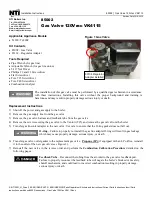
Sirius FS
3
GB/IE
1.0 GENERAL INFORMATION
1.1 DESCRIPTION OF APPLIANCE
1.1.1 General
The FS400 or FS525 model is a gas fired, low NOx, dual burner boiler system, for the supply
of low temperature hot water for space heating and primary hot water. The Sirius FS range
of boilers have extensive user programmable controls which can be configured to control
space heating, hot water, Solar and Primary circuits.
Fully automatic electronic controls are integrated into the boiler, with a wide range of
control and sensor options available. An outside temperature sensor is included as standard
to support full temperature compensated heating circuits. The controls also provides volt
free inputs to control the activation of heating and hot water circuits, a 0-10v input to
control demand, and volt free outputs to indicate burner on and fault. All of which can be
used when connected to an external BMS system.
Each burner module consists of a stainless steel combustion chamber, premix burner,
modulating fan and gas valve, ignition and flame detection electrodes and common flow and
return NTC sensors for accurate boiler management control. Fully premixed, radiating,
modulating burner, integrated with gas valve to deliver precise gas/air mixture throughout
the full modulation range.
A common combustion air intake manifold, takes air from the boiler room (type B23). An air
non-return valve gas mixing system is integrated into the air/gas mixture supply of each
burner, to ensure that flue products cannot contaminate the air supply, when the other
burner is not in operation. A separate electronic management system, monitors the position
of this air flap to ensure safe operation during all stages of boiler operation.
The safety and operation functions of each burner are managed by micro processor
controlled circuit boards, one for each of the burners. The Master ontroller also acts as the
cascade controller, switching/modulating the burners according to the demand and readings
from the systems sensors. Control is performed using comparison parameters between the
requested temperature and the global flow temperature.
1.1.2 Control Logic
At full demand, each burner is ignited one at a time, until both burners are operating at full
output. As flow and return temperatures increase, both burners will begin to modulate down
together, until both are operating at minimum input rate.
As flow temperatures begin to approach the calculated set point, one of the burners will
stop, leaving the other operating at minimum input rate. This will continue until both
burners have stopped and temperature flow requirements have been fully satisfied.






































